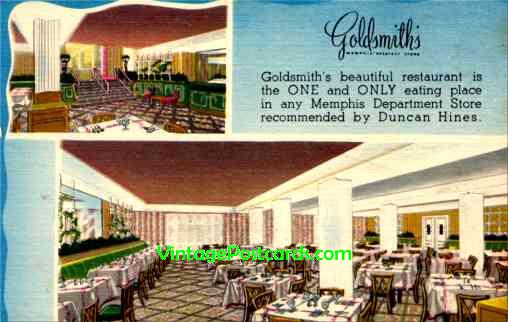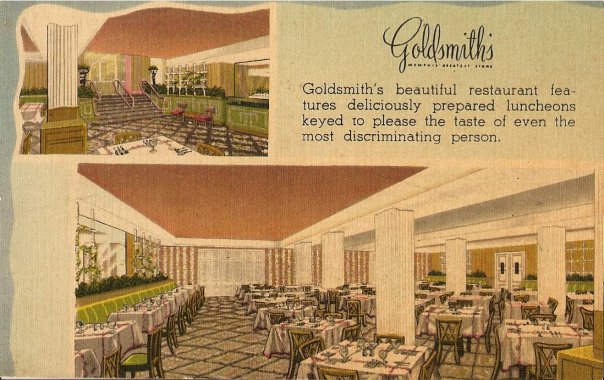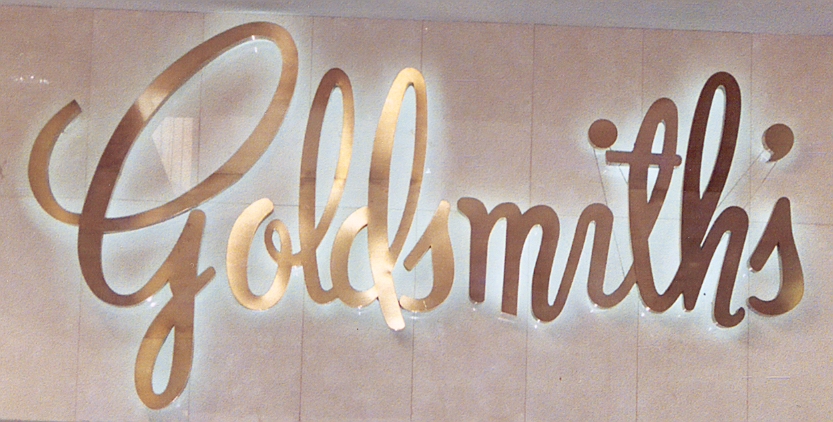
Goldsmith's is a well-known Memphis department store which traces its origins to the antebellum period and German immigrant Louis Ottenheimer. After moving to Memphis from Arkansas, where he had operated a provisions store, Ottenheimer opened a store on Main Street with partner Moses Schwartz. In 1867 Ottenheimer brought his nephews, Isaac and Jacob Goldsmith, to the United States and employed them in his Memphis store. As soon as the Goldsmith brothers saved five hundred dollars, they opened their own store, grossing twenty-five dollars on the first day of business. The Goldsmiths soon expanded to larger quarters on Beale Street. Memphis experienced several outbreaks of yellow fever during the 1870's. During the epidemic of 1878, the Goldsmiths kept the store open at least three hours a day.
By 1881 the brothers had bought their uncle's store, renaming it I. Goldsmith and Brother. The Goldsmiths prospered by adhering to a customer-friendly philosophy. Jacob Goldsmith became president of the store when his brother died. He initiated a Christmas parade, preceding Macy's famous event by more than a decade, and in 1960 the store opened the popular "Enchanted Forest" for children.
Goldsmith's became a true department store, among the first in the South, when it arranged merchandise by departments in 1902. It was the first Memphis store to install air-conditioning, escalators, a bargain basement, and a mechanical credit system called Charga-Plate.
When Jacob Goldsmith died in 1931, his sons Elias and Fred assumed management of Goldsmith's. In 1959 the store became an affiliate of Federated Department Stores. It is now part of Federated's RLG division--the combined Rich's, Lazarus's, and Goldsmith's department stores--headquartered in Atlanta.
Goldsmith's is a well-known Memphis department store
which traces its origins to the antebellum period and German immigrant
Louis Ottenheimer. After moving to Memphis from Arkansas, where he had
operated a provisions store, Ottenheimer opened a store on Main Street
with partner Moses Schwartz. In 1867 Ottenheimer brought his nephews,
Isaac and Jacob Goldsmith, to the United States and employed them in his
Memphis store. As soon as the Goldsmith brothers saved five hundred
dollars, they opened their own store, grossing twenty-five dollars on
the first day of business. The Goldsmiths soon expanded to larger
quarters on Beale Street. Memphis experienced several outbreaks of
yellow fever during the 1870's. During the epidemic of 1878, the
Goldsmiths kept the store open at least three hours a day.
By 1881 the brothers had bought their uncle's store,
renaming it I. Goldsmith and Brother. The Goldsmiths prospered by
adhering to a customer-friendly philosophy. Jacob Goldsmith became
president of the store when his brother died. He initiated a Christmas
parade, preceding Macy's famous event by more than a decade, and in 1960
the store opened the popular "Enchanted Forest" for children.
Goldsmith's became a true department store, among the
first in the South, when it arranged merchandise by departments in 1902.
It was the first Memphis store to install air-conditioning, escalators,
a bargain basement, and a mechanical credit system called Charga-Plate.
When Jacob Goldsmith died in 1931, his sons Elias and
Fred assumed management of Goldsmith's. In 1959 the store became an
affiliate of Federated Department Stores. The downtown Memphis location
was closed in 1993. It is now part of Federated's RLG division--the
combined Rich's, Lazarus's, and Goldsmith's department
stores--headquartered in Atlanta.
Selma Lewis, Memphis

